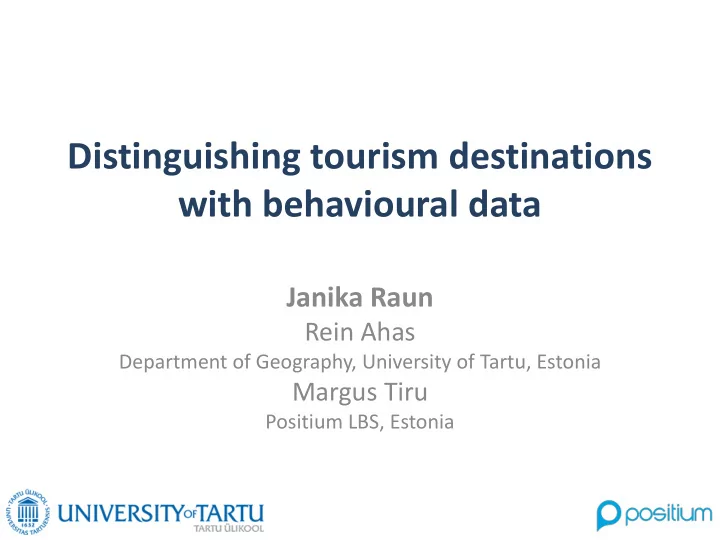

Distinguishing tourism destinations with behavioural data Janika Raun Rein Ahas Department of Geography, University of Tartu, Estonia Margus Tiru Positium LBS, Estonia
Introduction • Tourism is one of the fastest growing economic sectors in the world. • The need for differentiation in tourism destinations is becoming more important because it helps to avoid duplication in destination management and marketing. • Our aim is to propose a methodology for determination of tourism destinations by using behavioural data from mobile telephone positioning.
Theoretical backround • Destinations are complex multi-level entities. • Traditional theories look at tourism destinations as geographical areas (Hall 2000; UNWTO 2007). • New approaches consider tourism destinations as constantly changing socially constructed units (Framke 2002, Saarinen 2004, Saraniemi, Kylänen 2011) . • The meaning of a destination depends on the aim of the visit (Kuusik 2011) .
A conceptual model of the destination (Murphy et al 2000)
Theoretical backround • Destinations are complex multi-level entities. • Traditional theories look at tourism destinations as geographical areas (Hall 2000; UNWTO 2007). • New approaches consider tourism destinations as constantly changing socially constructed units (Framke 2002, Saarinen 2004, Saraniemi, Kylänen 2011) . • The meaning of a destination depends on the aim of the visit (Kuusik 2011) .
The intrigue of destination • Destination as a representation in peoples’ mind, which is hard to link to a certain geographical place or time? OR • Destination as a concrete measurable phenomenon with temporal and geographical dimensions?
Destination is a concrete measurable phenomenon with temporal and geographical dimensions.
Objectives: • To use behavioural indicators such as space-time mobility for distinguishing tourism destinations. • To propose a methodology for determination of tourism destinations by using behavioural data from passive mobile telephone positioning. • To develop an online tourism destination monitoring system based on behavioural data from mobile telephone positioning.
The location and image of the study area - Saaremaa
Data and Methodology • Passive mobile positioning data from January 1, 2011 to December 31, 2011. • Foreign tourists who performed call activities in Saaremaa. • The database consists of: visits’ ID -s, countries of origin, locations and times of the call activities. • The tourists with call days only in the Saare County and those, who performed call activities in other counties as well are observed separately.
Results (I) Measuring destination behaviour
Results • During the study period 32 221 tourists visited Saaremaa who made a total of 37 083 visits . • 42% of the tourists visited only Saaremaa and 58% visited other counties in Estonia as well. • 93% of the foreign tourists visited Saaremaa once during 2011. • More than a half (52%) of the repeat visitors were Finnish and 19% Latvian.
Foreign tourists who visited Saaremaa and the division of visits based on countries of origin Tourists Visits Number Percentage Percentage Number Country of origin of share of share of of visits tourists tourists visits Finland 11009 34% 14028 38% Latvia 7701 24% 8413 23% Sweden 2438 8% 2771 7% Germany 2176 7% 2322 6% Lithuania 2082 6% 2193 6% Russia 1617 5% 1759 5% United Kingdom 826 3% 907 2% Poland 720 2% 778 2% France 476 1% 489 1% Italy 369 1% 374 1% Other 2807 9% 3049 8% Total 32221 100% 37083 100%
The distribution of tourists according to their travel geography by countries of origin. Sweden 1567 871 Latvia 4159 3542 Lithuania 972 1110 United Kingdom 313 513 Visiting Russia 576 1041 only Finland 3797 7212 Saaremaa Germany 671 1505 Poland 210 510 Partly visiting France 130 346 Saaremaa Italy 67 302 Other 1041 1766 Total 13503 18718 0% 20% 40% 60% 80% 100%
The seasonality of visits made by tourists who partly visited Saaremaa by countries of origin. Italy 252 38 4 13 France 284 17 13 44 Germay 1235 138 59 180 Lithuania 818 223 46 112 Poland 340 99 59 64 Summer Finland 5423 1714 929 1791 Autumn UK 298 110 63 103 Winter Sweden 573 178 132 267 Spring Latvia 1878 1103 499 590 Russia 467 218 313 157 Other 1266 262 160 291 Total 12834 4100 2227 3612 0% 20% 40% 60% 80% 100%
Other visited counties in Estonia besides Saaremaa
Independent destination or not? • Among tourists who visited also other places in Estonia the time spent in Saaremaa constitutes for Finns (57%), for Swedes (52%) and for Latvians (51%) of total visit – for them Saaremaa can be considered as a tourism destination , because they spent more than half of their visitation time in Saaremaa. • For other distant countries (e.g. Italy, France) Saaremaa is just one place to visit in Baltic States or in Estonia.
Results (II) Developing destination monitoring software
The application of Estonian tourism destinations among foreign visitors www.positium.ee/eas_keskused
The application of Estonian tourism destinations among foreign visitors www.positium.ee/eas_keskused
Conclusions • Behavioural data collected with passive mobile positioning gives us an opportunity to measure tourism destinations quantitatively. • The data is stored automatically, we can choose the time period and set different margins. • Web-based applications can be developed. • Knowing the temporal and spatial distribution of visits helps to avoid duplication in destination management and marketing.
Thank you for your attention! Janika Raun janika.raun@gmail.com
Recommend
More recommend